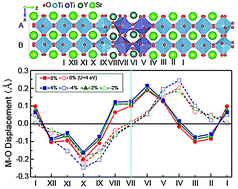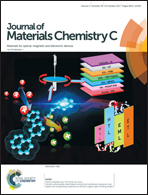Strain-controlled insulator–metal transition in YTiO3/SrTiO3 superlattices: effect of interfacial reconstruction†‡
Abstract
The structural, magnetic, and electronic properties of short-period STO/YTO superlattices consisting of Mott insulator YTiO3 (YTO) and band insulator SrTiO3 (STO) are investigated using the density-functional-theory plus U method. It is found that an insulator–metal transition occurs when a compressive strain is applied, and no transition occurs for tensile strain. Structural analyses reveal that the electronic transition accompanies a structural phase transition, restoring the inversion symmetry, and the strain compresses the interfacial oxygen octahedra of Ti and thus makes the d energy levels of the interfacial Ti atoms move upward so as to induce electron transfer to the STO layer. This mechanism is supported by the fact that a similar insulator–metal transition also occurs when the on-site U is reduced. These findings can improve our understanding of the structural and electronic properties of such oxide superlattices and heterostructures.



 Please wait while we load your content...
Please wait while we load your content...